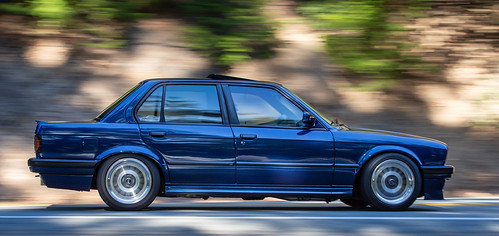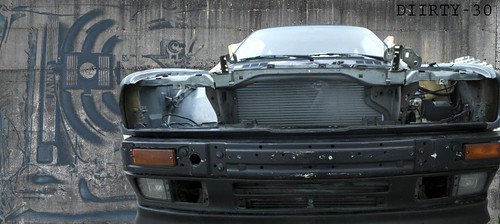If one were to crack an oil pan and spill oil and not notice it how long before damage occurs? what would be your plan of action for inspecting the motor, starting with basic tests/inspection to finally cracking open the motor.
Theoretical question
Collapse
X
-
Theoretical question
My don't quote me list:
Originally posted by george gravesI could be wrong, but I don't think it's a smog test type of thing. IIRC think it's against CA law to *sell* a dual outlet muffler as a replacement for a car that came from the factory with a single. But don't quote me on that.Tags: None -
As soon as you lose oil pressure, you are doing damage to the engine. The longer the engine runs, the worse the damage. Any more than a few minutes with no oil and the engine is scrap.Comment
-
Hot engine + no oil = bad I get it but what exactly happens? I have it in my head that because of the intense heat and lack of oil engine parts would "weld" to each other is that correct? I was basing that off of the term seized engine when oil pans bust, not sure if I am correct.
If it is correct, why in some instances could you just get away with rebuilding the engine (i.e. replacing a few parts) ? atleast that is what I am lead to believe from the light reading I did through google. Is it because it varies due to variables (temp, etc) like cabriolet says? If so, how would these engine components break with lack of oil? I can understand pistons and rings but what about valves n such?
Excuse my ignorance, just trying to wrap my head around this concept.
My don't quote me list:
Originally posted by george gravesI could be wrong, but I don't think it's a smog test type of thing. IIRC think it's against CA law to *sell* a dual outlet muffler as a replacement for a car that came from the factory with a single. But don't quote me on that.Comment
-
Parts don't get hot enough to weld. Absent oil they just grind themselves til they simply don't slide any more and the engine seizes. Bearings to crank, pistons to bores, rockers to shaft etc etc.Seat Shocks....I have passed the baton to John Christy from Ninestitch. Email John or Garrett at ninestitch1@gmail.com
https://www.r3vlimited.com/board/sho...86#post4944786
Alice the Time Capsule
http://www.r3vlimited.com/board/showthread.php?t=360504
87 Zinno Cabrio barn find 98k and still smells like a barn. Build thread http://www.r3vlimited.com/board/show...20#post3455220Comment
-
Parts can get hot enough to weld. Typically a rod bearing seizes, which is usually immediately followed by a broken rod going through the side of the block.
How long the engine can run with no oil pressure before complete failure occurs depends on load and engine rpm. At 3k rpm under load, it will be a matter of seconds before bearing damage occurs and shortly thereafter complete failure. If such an event happens, the only diagnosis of the damage comes from a teardown and inspection.The car makes it possible, but the driver makes it happen.
Jim Levie, Huntsville, ALComment
-
My don't quote me list:
Originally posted by george gravesI could be wrong, but I don't think it's a smog test type of thing. IIRC think it's against CA law to *sell* a dual outlet muffler as a replacement for a car that came from the factory with a single. But don't quote me on that.Comment
-
Simple case. Lack of oil pressure due to the oil exiting the sump. Expect EVERYTHING in the motor to be damaged, even if it was shut down pretty quickly. You tell the customer it's not great for the engine to suffer oil loss and you cannot quote or recommend anything until the motor is pulled down and inspected.
Things like rod and main bearings are wet bearings, ie the oil actually forms the bearing when the component is rotating. It's called hydrodynamic lubrication. The oil is part lubricating, but the other side is it actually provides a cushion for the components to ride on, and only functions when the crankshaft is rotating to draw oil into the bearing as it turns. If a constant oil supply is maintained, this film of oil is always present and none of the rotating components should touch. The other side of it is, people forget that oil actually helps cool and transfers heat away from friction sources too.
Think of things like shells as basically being a soft wear item designed to protect the crankshaft journals from damage. Aside from providing an extremely long service life if oil quality is maintained, they allow you to replace these wear items without scrapping the block. If you take away it's oil surface, massive amounts of friction are created between these surfaces almost as soon as they run out of oil supply. How long it takes is largely a guess, though you can usually safely talk in seconds, rather than minutes. Although things like bearing journals are significantly harder than the bearing shells, the amount of heat developed is pretty severe. I've seen them weld shells clear to rod journals on the crank. Usually what happens is the bearing shell develops hot spots and starts to break up, depositing itself on the crank. If it continues to run the heat is transferred through the crank and can actually end up damaging the journals or warping the crank itself. Worst case scenario is the journal is now out of round and the shell is stuck solid to the crank. If the crank can be salvaged it is really a matter of how much damage it has sustained and how far it would need to be linished back to roundness, removing any damage and restoring the surface in the process. Sometimes this is impossible as you cannot find an oversized bearing large enough to make up this difference. In extreme cases the block will need to be line bored as it has warped across the bearing caps too and the crankshaft will bind when reinstalled.
Similar thing kind of happens with stuff like gudgeon pins in pistons and camshaft bearings in motors like M20's which don't have a shell, the journal is machined into the head itself and cannot be reshelled. So you end up with the surfaces being damaged from the heat with usually pitting forming on the surfaces, sometimes they even bind up, directly to contact surfaces.
The longer it's run and the hotter it gets, you can say the more components that are likely to have suffered damage, but as a general rule, is any engine is starved of oil, you are only guessing what damaged it has suffered until you pull it down and inspect. There is no rule for any engine, even two side by side that can predict what is damaged and what isn't. Anything with a surface lubricated by oil has the possibility of suffering some sort of damage. Some is superficial, others require total overhaul or result in junking the motor.Just a little project im working on
- http://www.lse30.com -Comment
-




Comment